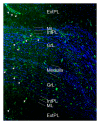Olfactory dysfunction in patients with neuromyelitis optica
- PMID: 24187622
- PMCID: PMC3800619
- DOI: 10.1155/2013/654501
Olfactory dysfunction in patients with neuromyelitis optica
Abstract
Background. Neuromyelitis optica (NMO) is a severely disabling autoimmune disorder of the CNS, which mainly affects the optic nerves and spinal cord. However, recent studies have shown that extra-opticospinal are more common in NMO than previously thought. Objective. To investigate olfactory function (OF) in patients with neuromyelitis optica (NMO) versus healthy controls (HC). Methods. Psychophysical testing of the orthonasal OF was performed using the Threshold-Discrimination-Identification test (TDI), measuring different qualities of olfaction, in 10 unselected NMO patients and 10 HC. Results. Five of 10 NMO patients (50%) showed hyposmia, while all 10 HC were normosmic. Moreover, NMO patients had significantly lower mean TDI-scores compared to HC, based on a poorer performance in both the Discrimination and the Identification subtests. Conclusions. Our results suggest that hyposmia might be part of the expanding clinical spectrum of NMO.
Figures


Similar articles
-
Neuromyelitis optica.Int MS J. 2006 May;13(2):42-50. Int MS J. 2006. PMID: 16635421 Review.
-
Neuromyelitis optica-IgG in idiopathic inflammatory demyelinating disorders amongst Hong Kong Chinese.Eur J Neurol. 2009 Mar;16(3):310-6. doi: 10.1111/j.1468-1331.2008.02376.x. Eur J Neurol. 2009. PMID: 19138340
-
Neuromyelitis optica: clinical syndrome and the NMO-IgG autoantibody marker.Curr Top Microbiol Immunol. 2008;318:343-56. doi: 10.1007/978-3-540-73677-6_14. Curr Top Microbiol Immunol. 2008. PMID: 18219825 Review.
-
A serum autoantibody marker of neuromyelitis optica: distinction from multiple sclerosis.Lancet. 2004 Dec 11-17;364(9451):2106-12. doi: 10.1016/S0140-6736(04)17551-X. Lancet. 2004. PMID: 15589308
-
Neuromyelitis optica-IgG testing in an Indian cohort with neuromyelitis optica and related demyelinating disorders: Our experience.Ann Indian Acad Neurol. 2013 Jul;16(3):376-9. doi: 10.4103/0972-2327.116945. Ann Indian Acad Neurol. 2013. PMID: 24101820 Free PMC article.
Cited by
-
Unilateral olfactory sensitivity in multiple sclerosis.Physiol Behav. 2017 Jan 1;168:24-30. doi: 10.1016/j.physbeh.2016.10.017. Epub 2016 Oct 22. Physiol Behav. 2017. PMID: 27780720 Free PMC article.
-
Systemic Lupus Erythematosus (SLE) Complicated by Neuromyelitis Optica (NMO - Devic's Disease): Clinic-Pathological Report and Review of the Literature.Clin Med Insights Case Rep. 2014 Jun 2;7:41-7. doi: 10.4137/CCRep.S15177. eCollection 2014. Clin Med Insights Case Rep. 2014. PMID: 24948869 Free PMC article.
-
Common and Rare Manifestations of Neuromyelitis Optica Spectrum Disorder.Curr Allergy Asthma Rep. 2016 Jun;16(6):42. doi: 10.1007/s11882-016-0619-4. Curr Allergy Asthma Rep. 2016. PMID: 27167974 Review.
-
Neuromyelitis optica: clinical features, immunopathogenesis and treatment.Clin Exp Immunol. 2014 May;176(2):149-64. doi: 10.1111/cei.12271. Clin Exp Immunol. 2014. PMID: 24666204 Free PMC article. Review.
-
Comparative Study of Brain fMRI of Olfactory Stimulation in Neuromyelitis Optica Spectrum Disease and Multiple Sclerosis.Front Neurosci. 2022 Jan 10;15:813157. doi: 10.3389/fnins.2021.813157. eCollection 2021. Front Neurosci. 2022. PMID: 35082598 Free PMC article.
References
-
- Wingerchuk DM, Lennon VA, Pittock SJ, Lucchinetti CF, Weinshenker BG. Revised diagnostic criteria for neuromyelitis optica. Neurology. 2006;66(10):1485–1489. - PubMed
-
- Mesholam RI, Moberg PJ, Mahr RN, Doty RL. Olfaction in neurodegenerative disease: a meta-analysis of olfactory functioning in Ahlzheimer’s and Parkinson’s diseases. Archives of Neurology. 1998;55(1):84–90. - PubMed
-
- Doty RL, Li C, Mannon LJ, et al. Olfactory dysfunction in multiple sclerosis. The New England Journal of Medicine. 1997;337(7):p. 507. - PubMed
-
- Wingerchuk DM, Lennon VA, Lucchinetti CF, Pittock SJ, Weinshenker BG. The spectrum of neuromyelitis optica. The Lancet Neurology. 2007;6(9):805–815. - PubMed
LinkOut - more resources
Full Text Sources
Other Literature Sources
Research Materials

